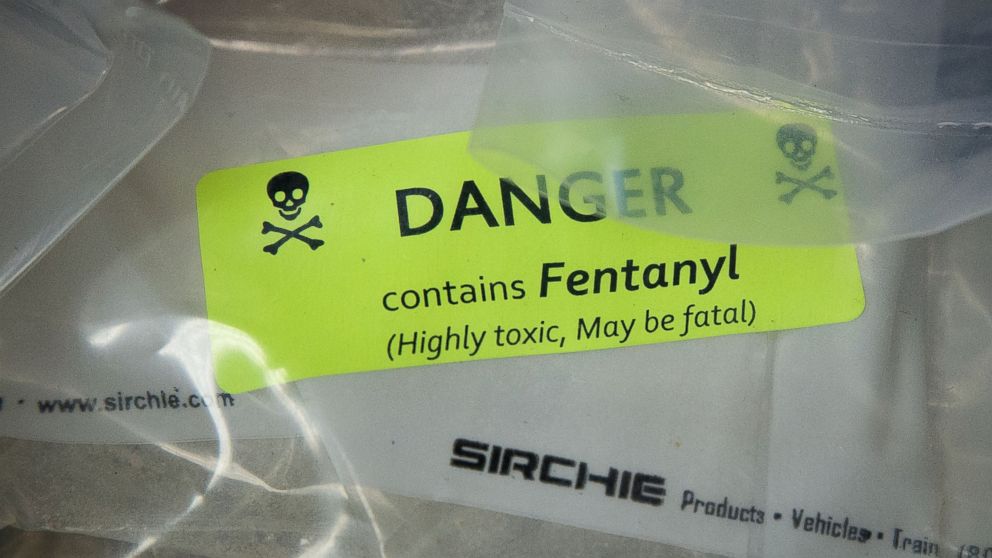Why Superpotent Synthetic Opioids Are 'Crazy Dangerous,' DEA Says
Synthetics are significantly more potent than heroin and many other opioids.

— -- As the opioid epidemic has continued to grow in multiple parts of the country, extremely potent synthetic forms of the painkillers — especially fentanyl and carfentanil — have become more common among everyday users, according to U.S. authorities.
Last week, the Drug Enforcement Agency (DEA) issued a public warning to law enforcement about the safety risks of taking or interacting with synthetic opioids, especially carfentanil and fentanyl. The agency warned the drugs can be deadly, even in very low quantities.
"Carfentanil is surfacing in more and more communities," DEA Acting Administrator Chuck Rosenberg said in a statement on Friday. "We see it on the streets, often disguised as heroin. It is crazy dangerous. Synthetics such as fentanyl and carfentanil can kill you. "
In Ohio, rates of opioid overdoses have been growing and one public health official issued a public health warning after police linked carfentanil to opioid overdoses in August and September.
"Fentanyl and heroin have already killed 300 people this year and we are headed for double the number of fatalities as 2015," Cuyahoga County Medical Examiner Dr. Thomas Gilson said in August. "The detection of carfentanil here is a very disturbing development in the ongoing illegal opiate crisis. This drug is intended for use as an anesthetic in large animals and veterinarians take special precautions just handling it. Small amounts are rapidly fatal."
This past weekend, seven fatal drug overdoses were reported in Cuyahoga County, leading Gilson to issue another public health warning, although the cases have not been connected to a particular drug.
"This cluster of deaths is deeply concerning. Although there is no clear link between the individuals, this number clearly raises the possibility of a very deadly drug in our community," said Gilson in a statement yesterday.
When synthetic opioids are introduced, they create a tranquilizing effect by attaching to certain brain receptors, according to Dr. David Edwards, Clinical Service Chief for Chronic Pain Service at Vanderbilt University Medical Center. An overdose can occur because the same receptors also affect basic survival functions.
"The opioids are acting on these opioid receptors, they're reducing your brain's perception of pain," Edwards explained.
"But these same receptors are controlling your breathing and controlling your transit of food through the GI tract," he added, which "blocks transmission to the brain's receptor and stops the drive to breathe."
Fentanyl
Fentanyl is used primarily in operating rooms and is thought to be 50 to 100 times more potent than heroin. It's a synthetic opioid first created in the 1950's and used as an intravenous anesthetic, according to medical literature.
When used intravenously, the drug starts working in one minute compared to five minutes for morphine, according to a 2011 published review in the Journal of Midwifery and Women's Health.
Edwards explained that since it works so quickly, fentanyl can cause a potentially fatal overdose much faster than other opioids.
"Morphine takes 20 to 30 minutes to peak," in the bloodstream said Edwards. Fentanyl, "it peaks in your blood within five minutes."
Edwards said he's heard of drug dealers warning users to not experiment with fentanyl since it's so dangerous in such a small amount.
Ray Isackila, an addiction and recovery services specialist at University Hospitals Cleveland Medical Center, said synthetic fentanyl is cheaper to make than heroin. Drug dealers or users sometimes mix it with heroin to reduce cost or give more punch to lesser quality heroin, creating "tainted" batches.
"People started mixing fentanyl in with not-so-pure heroin to make it more powerful," said Isackila. He said that drug users are usually unaware of when the drugs have been tainted with fentanyl, so they may not know how the drug will affect them.
Carfentanil
Carfentanil is a variation on fentanyl developed for animal, not human, use. It was developed as an anesthetic for large animals, including elephants, and its potency is thought to be "2,500 times more than heroin," according to the Cuyahoga County public health commissioner.
"It is suggested to be 10,000 times stronger than morphine," said Isackila. "It takes a microscopic amount of this drug to kill a person."
The drug is so dangerous the DEA warned law enforcement last week to take protective measures if they think they have encountered synthetic opioids, especially carfentanil, since the drug can be absorbed through the skin.
"Carfentanil and other fentanyl-related compounds are a serious danger to public safety, first responder, medical, treatment, and laboratory personnel," the DEA said on its website. "These substances can come in several forms, including powder, blotter paper, tablets, and spray –- they can be absorbed through the skin or accidental inhalation of airborne powder."




